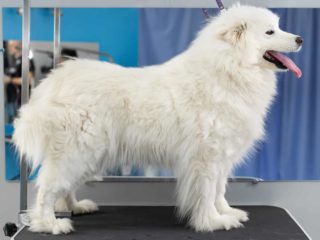Our dogs’ tails offer a unique window into their emotions and thoughts. This is especially true for Pitbulls, known for their expressive tails. This guide delves into the nuances of Pitbull tails, exploring everything from their shape to their role in communication and health. Stay tuned till the end for a glimpse into our most popular Pitbull articles.
What does a Pitbull tail look like?
A normal Pitbull tail extends out from the spine in a straight line and is angled downward from its back. Its thickest point is from the rear end of your Pitbull and it should slowly taper to a point. The hair on its tail is long and sleek, but maybe a bit thicker than elsewhere on its body.
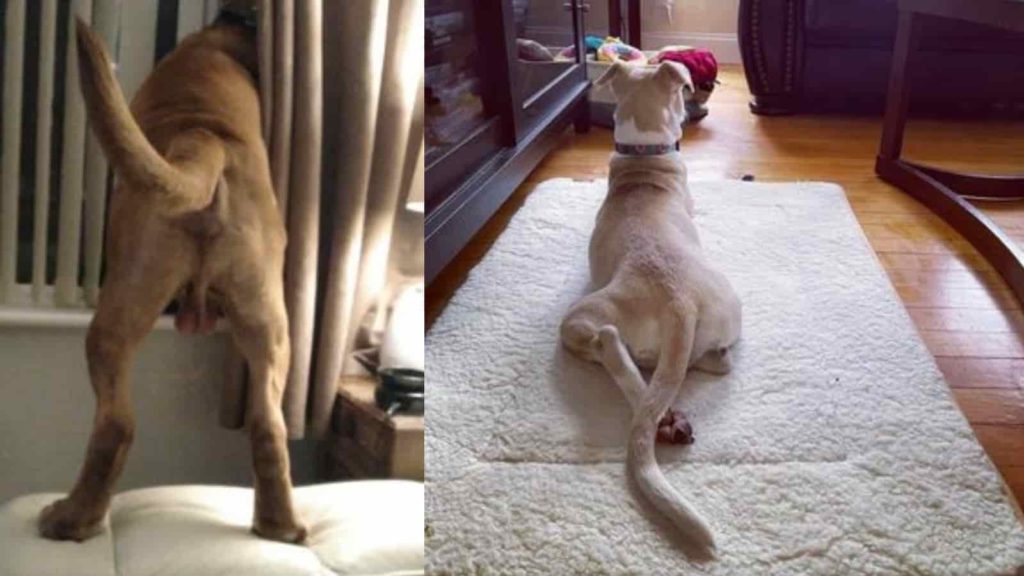
Many owners talk about the love-hate relationship they have with their bully’s tail! It’s fun to see them be so expressive with it, but it can easily become and dangerous whip-like feature on an over-excited pitbull!
A Pitbull’s tail has been referred to as a pump handle or a whip. Their tail is a natural extension of the dog’s spine and comes to about the top of the hock. When the dog is relaxed the tail is carried low. When the dog is excited the tail is carried in the upright position and is usually expressive and wagging.
If you own a pitbull that has a tail that looks different than this description it’s usually nothing to be concerned about. Variations are normal and generally not a concern. Some dogs may have tails that don’t conform to the usual standard-looking pitbull tail.
Genetics of the mother and father of the dog play a big part in how the tail will look. Some Pitbulls may have an unusually long tail that goes beyond the point of the hock. Some may have a naturally bobbed tail, kinked tail, or tail that is carried higher than normal.
Pro tip: If you are interested in the best grooming tools for your dog you can find them by clicking here now!
How long are Pitbull’s tails?
A Pitbull’s natural tail is on average 8 to 13 inches long however it is not uncommon for Pitbulls to have tails ranging from 4 inches to 14 inches long. The taller your Pitbull is the longer its tail will be. Pitbulls who have docked tails will have tails ranging from 2 inches to 5 inches.
Disclaimer: This post may contain affiliate links. We only recommend high-quality products that are used and recommended by real owners. If you use these links to buy something we earn a small commission.
The standard length is generally the tip of the tail ending at the dog’s hock. You will find other lengths on Pit Bulls, but it’s not considered standard.
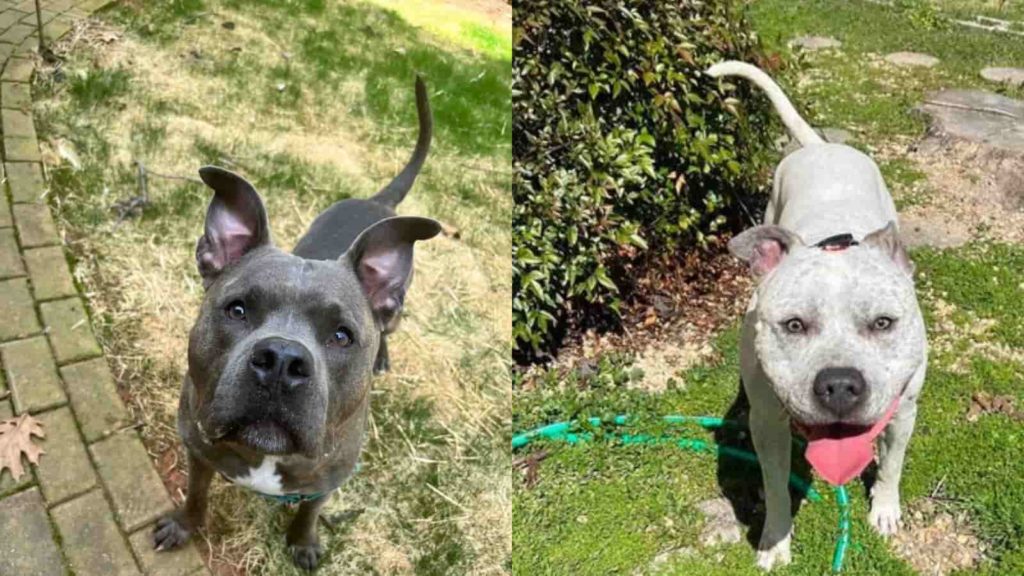
Do Pitbull have curled tails
Pitbulls generally do not have curly tails. Their tail can have a slight curve shape like a crescent, but going by high-quality breeding standards the tail should be held downwards. If your Pitbull has a very curly tail it could be the genetics of the parents or may mean it’s not purebred.
Genetics of the mother and father play a big role in how your Pitbull’s tail will look. Some Pitbulls have a more curved tail because that is how the mother and father of your Pitbull pup looked.
There is a higher chance that if your dog has a very curly tail it could be mixed with another breed.
Fun Fact: What would you think of a Pitbull Wolf Mix? Check out this article to see if it’s possible.
Some breeds that have curly tails that may be mixed with your Pitbull are a Pomeranian, a Pug, or a Chow Chow.
If your Pitbull has a curled tail it is not usually anything to worry about. An arch or curve to the tail is just fine for a Pitbull that is a pet. If you are looking for a show dog however you will need to make sure you have a Pitbull with a low-set straight tail that follows the breed standards set by the AKC.
If your Pitbull has a very curly tail or a kink in its tail it could indicate a deeper problem.
As a Pitbull’s tail is an extension of its spine the posture of your Pitbull’s tail can give you some clues into your dog’s spine health.
If you notice that your dog is sitting with its back end slightly sideways and the tail looks to be off to one side it could mean that their spine is out of alignment and it would be best to get him an adjustment.
It would also be recommended that you don’t breed your Pitbull as this flaw can be passed down to the puppies and become more problematic for each generation going forward.
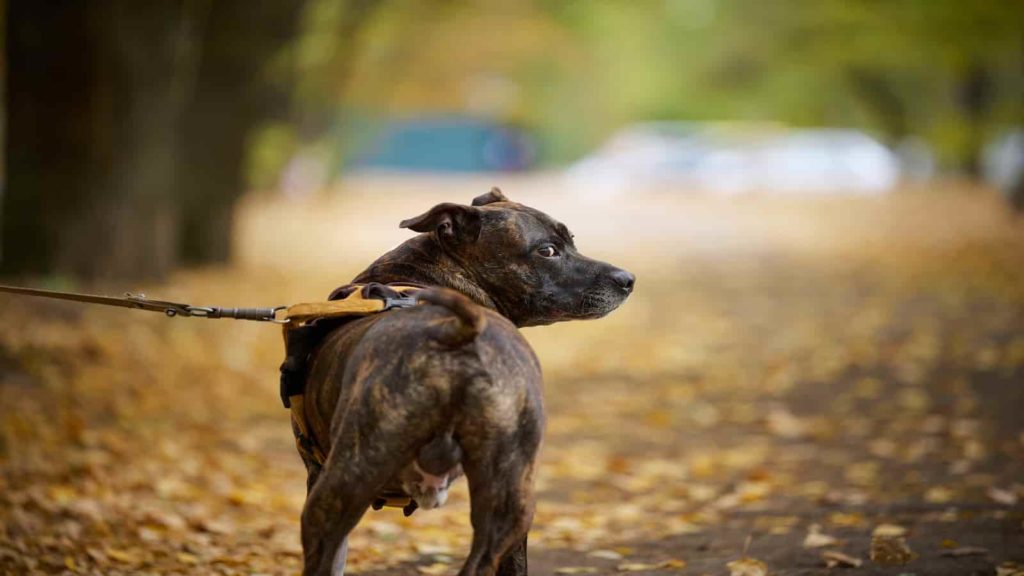
Do Pitbulls get their tails docked?
Pitbulls generally do not have docked tails. The standard for American Pit Bull Terrier is to leave them long and natural. If a Pitbull has its tail docked it’s likely because they are used for fighting. A docked tail for a fighting pitbull would give the dog an advantage.
Pitbull fighting is very wrong and offensive. Using a dog in this way is illegal and a felony in all 50 states! Unfortunately, there are still some people that think it’s ok. If they plan on using a dog in this way they will often dock the tail as to make it less of a liability in a dog fight. Tails can easily get injured if not taken care of properly.
Please keep in mind that if you see a Pitbull with a docked tail it does not automatically mean that the dog has been or will be used in dogfighting. Some Pitbulls may need their tails docked for medical reasons.
For example, if a dog’s tail is injured from wagging it too hard on a sharp surface and it can’t be safely repaired then amputation may be necessary. This is different than docking a dog’s tail when it’s a puppy.
Docking tails is a highly controversial subject. You will find dog owners who will argue for both sides. Most Pitbull breeders will not dock their litters’ tails.
Docking is a tradition that dates back to Roman times when they would dock a dog’s tail because they believed it prevented rabies. In the United States, the practice of docking tails for cosmetic reasons began in the 1950s. This was done to conform to the breed standards and be accepted into the AKC.
Pitbulls are not recognized by the AKC and have no reason to get their tails docked.
Fun Fact: In the 18th century there was a tax imposed on all dogs unless they were working dogs. So naturally, people decided to cut all ‘Working dogs’ tails off to tell them apart from non-working dogs. And well, that led to owners cutting off their non-working dogs’ tails just to avoid getting taxed.
Can a Pitbull be born with a stub tail?
Generally, Pitbulls are not born with a natural stub tail. A short tail most likely means it was docked as a newborn. However, a variant in the DNA of an important gene during development in the womb may result in a congenitally short (bobtail) or completely absent tail.
Some breeds like Australian Shepherds have been bred to favor this gene and are more likely than Pitbulls to favor a natural bobtail.
If your dog has a short tail and you don’t know if it has been docked or not the only way to know if your dog carries this gene or not is to do a DNA test.
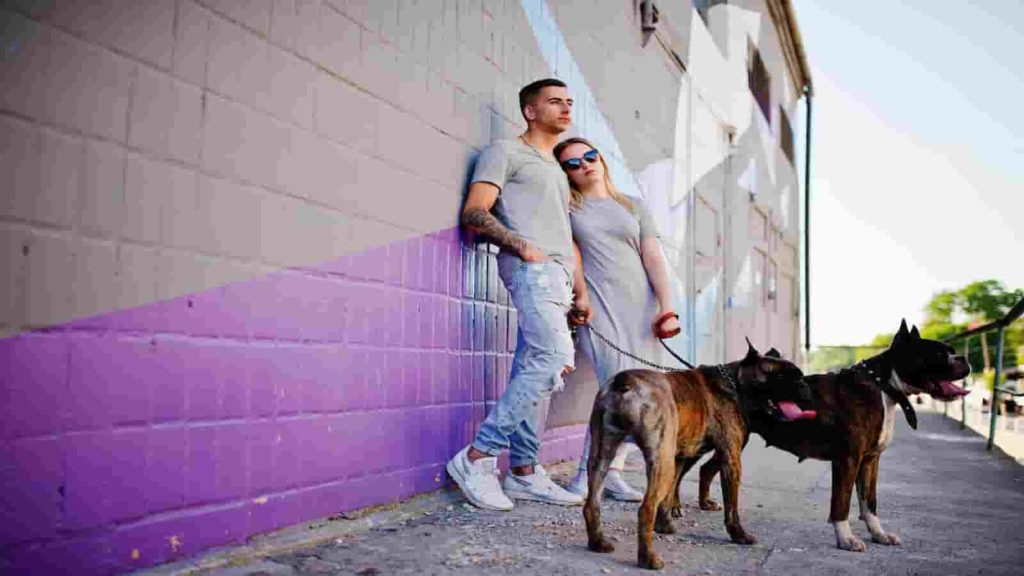
Pitbull tail wagging and communication
Pitbulls wag their tails for many different reasons. It’s a big part of how they communicate with you. Wagging their tail doesn’t always mean they are happy. They could be conveying other emotions like nervousness or fear as well. The key to understanding their tail wags is to put it together with all the other contextual clues they are giving you. What are their ears doing, their eyes, and their posture? Noticing these things as well will help you know why your Pitbull is wagging its tail.
Here are some things your Pitbull could be communicating to you with its tail.
- Calm and chill – Tail in the natural resting position. Sleeping or resting or casually walking around.
- Greeting or I love you – Usually, a big carefree wag, accompanied by eye contact, coming to you and jumping on you or trying to get your attention.
- Curious or unsure – Backwards and gentle wagging. Maybe sniffing around a little, intense and curious staring. Looking to you for reassurance.
- I’m nervous or scared – The tail between their legs and possibly slightly moving. Body tense, eyes down, ears laid back. Could also be trying to communicate a submissive position.
- Aggression – Tail high in the air and rigid. Poised, rigid, and making eye contact. Could be barking or growling as well.
- Happy and excited – Fast carefree wagging. Wiggling body, happy facial expressions. Body not tense, possibly going in circles around the object causing excitement such as a treat or toy.
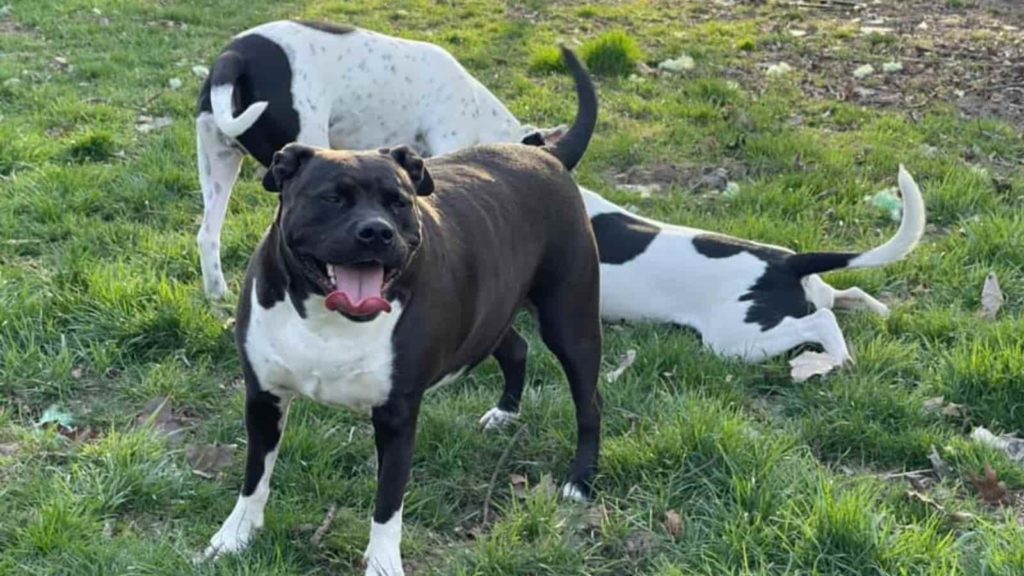
There’s also been a study done that shows the direction in which your dog wags its tail can show positive or negative emotions. Wagging their tail towards the right side of their body can indicate more positive emotions such as being relaxed, and happy. Wagging their tails on the left side of their body is a sign of more negative emotions such as nervousness or fear.
For most Pitbulls wagging their tails to communicate is a natural and normal thing for them to do. Occasionally you will find a Pitbull that doesn’t wag its tail at all. Don’t worry, you are not alone.
If your Pitbull doesn’t wag its tail it’s most likely just part of its personality or genes. It could also be that they have an extra curly or short tail that makes it more difficult for them to wag, but it could also indicate a medical problem and they should be seen by your vet to rule out any serious issues.
If your Pitbull has recently stopped wagging its tail then there are some other things you should consider. If you have just moved, or they are new to your home this could just mean they are nervous and need some time to get acclimated to their new environment.
Some dogs are bigger tail-waggers than others. If your Pitbull doesn’t wag its tail at all then you will have to learn to identify other body language cues to help you understand what they are trying to tell you.
Pitbull tail problems and what to do
If your Pitbull is temporarily holding its tail in the down position it’s most likely an indication of submission or fear, but if your Pitbull is unable to hold its tail upright as it has in the past or seems to be in pain it could indicate one of the following:
- Swollen anal glands
- Bent or broken Tail
- IVDD (Intervertebral disk disease)
- Patellar Luxation
- Tail Tip Necrosis
- Limber Tail (swimmer’s tail)
- Constipated
Swollen anal glands in a Pitbull
If you notice your Pitbull chasing its tail a lot more than usual, scooting its bum across the carpet, or biting/licking around the base of its tail it could be that its anal glands are blocked and swollen.
Sometimes the solution to your dog’s tail problem is as simple as getting your dog’s anal glands expressed. You can have your vet do it, or learn to do it yourself.
If you notice any blood, redness, or swelling around the anus you need to take your dog to the vet ASAP! Excessive itching, scratching, and swelling can cause trauma to the area or increase the chances of infection.
Bent or broken tail in Pitbulls
Another reason your dog may have for holding its tail down curled or tucked under between its legs is a bent or broken tail.
Signs of a broken or sprained tail
- Swelling
- Bend or kink in the tail
- Difficulty or pain moving the tail
- Wagging it to one side
- Holding it in an unusual position
If your dog seems to be in any pain or is licking or biting at its tail more than usual that can be an indication that something isn’t right.
Broken or strained tails are usually caused by a traumatic injury such as being stepped on or slammed in a door.
It can be extremely painful to your dog and needs to have immediate attention from a vet. Minor injuries will most likely heal with rest and immobility. More serious injuries may require surgery or amputation.
If your dog has always had a bend in its tail and it doesn’t seem to be in any pain then this is probably an indication that at some point in its past it may have broken or strained its tail.
Unfortunately, A lot of owners who have adopted rescues have seen this in their sweet Pitbull.
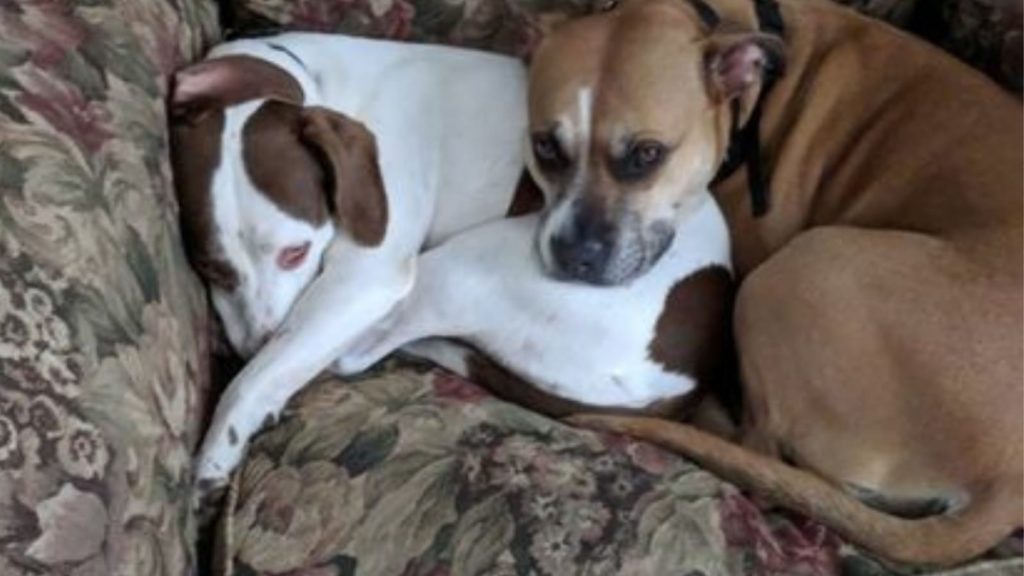
IVDD in Pitbulls
Another somewhat serious problem that can cause tail discomfort in Pitbulls is a back issue known as IVDD. The technical term for this is Intervertebral disk disease (IVDD) it can also be described as a ruptured, slipped, bulging or herniated disk in your dog’s neck or back.
This type of back issue is fairly common in smaller dogs but can happen in a few larger breed dogs like Pitbull Terriers.
This problem is caused by a herniated disc and usually presents in younger to middle-aged dogs.
Here is a good resource to look at if you feel like this might be your Pitbulls problem.
Pitbull Patellar Luxation
If your Pitbull is constantly holding his tail down or it seems to be in a down position more often than the normal resting position this could indicate a problem called Luxating Patella.
This is just a fancy way to stay a misplaced kneecap. Besides the tail, another indication this may be the problem is if you notice your dog stretching out their rear limbs and walking in circles, or possibly yelping or whining in pain.
If it seems to be causing your dog a lot of pain or the problem is not going away it’s best to take your dog to the vet. They will assess the situation and if this is a recurring problem for your dog may recommend surgery to fix the problem. If surgery is performed it should be a permanent fix for your dog.
Pitbull tail infection (Tail Tip Necrosis or Happy Tail)
This is a very serious problem and unfortunately happens more often in Pitbulls than other breeds. Because Pitbulls can wag their tails so hard and vigorously they can be subject to having this problem.
It can be important that you learn to identify it right away so the issue can be dealt with before it causes permanent damage.
This can be caused by the constant beating of the tail against objects that may harbor bacteria. If the tail gets an open wound and the bacteria gets in it can lead to an infection that will spread and cause the tissue to become damaged or start dying.
Watch for hair loss or baldness at the end of the tail. Excessive itching, bloody or brittle skin, foul-smelling, excessive biting of the tail.
Take your dog to the vet right away if you notice any of these things in your dog. The vet will assess and most likely have to amputate the infected part of the tail. This may be a very sad thing to have to deal with, but if the infection spreads it could endanger your dog’s life.
Pro Tip: If you are not able to get a hold of a vet near you, or you want to avoid an unnecessary ER trip, there are online resources that you can turn to. Here is our best recommendation:
Pawp: a 24/7 digital clinic for pets that connects you to an experienced vet
Why we love it:
🐾 Answers 24/7! 🐾 No waiting! 🐾 Get Answers Online with Local Vets! 🐾 Quick Response Time! 🐾 Easy Sign UP!
Try Pawp 7 Days For Free
What is Limber (Swimmer) Tail In Pitbull and What to Do
If you notice your Pitbull tail hanging down and it looks limp and unnatural then he may have a condition known as Limber Tail.
Limber tail. Also known as swimmer’s tail, frozen tail, dead tail, broken wag, or cold tail is a condition that causes your dog to hold his tail limp and down instead of the usual upright position. Its official name is Acute Caudal Myopathy.
It is most likely to happen after your dog has had very active or strenuous play, exercise, or excessive tail wagging. Sometimes a lot of swimming can cause it, being in cold wet weather, if they are confined to their crate too long, or if your dog’s tail is wagging and getting whacked on various surfaces.
This could cause your dog pain and swelling in their tail, making it difficult to sit. Usually, this condition will go away on its own after a few days of rest. It’s important to try and limit exercise and movement if you notice that your dog is experiencing this problem. If it is causing your dog a lot of pain then consulting your vet is a good idea.
Usually, this isn’t a chronic problem, but it is a good idea to figure out what may have triggered it in the first place and try to avoid that activity if possible. Coldwater play, or being confined in a crate too long are often things that could trigger this condition.
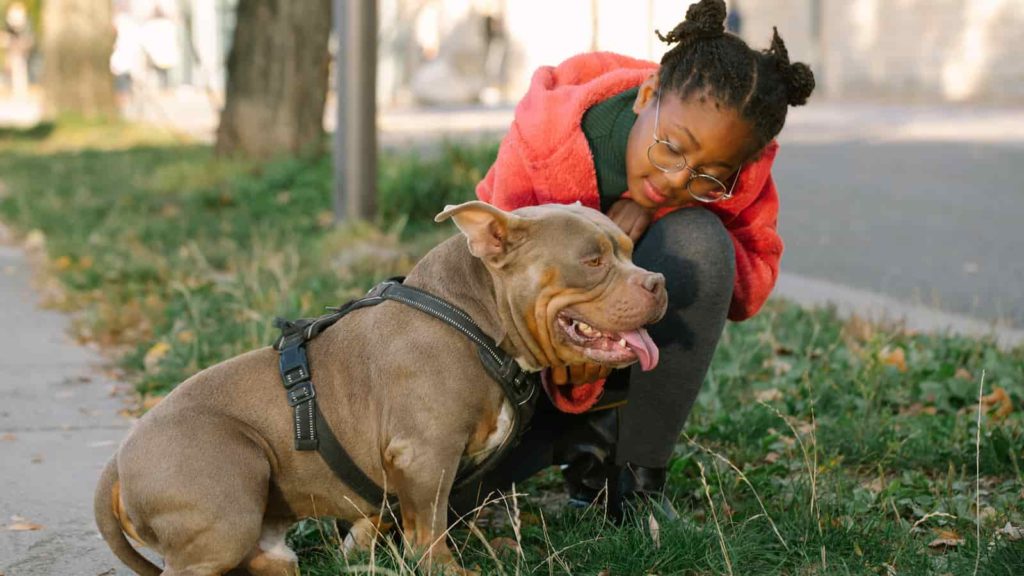
Pitbull chasing or biting its tail
For the most part, if your Pitbull is chasing its tail it’s most likely just a harmless and adorable game. Puppies tend to do this a lot because they are so playful and exploring more about their world while discovering their fun long tails. If your dog is chasing his tail it might be because he’s bored or it’s just a fun game for him.
The problem comes when your dog is obsessively chasing its tail and it seems like they are in pain stressed or licking and biting its tail causing things like bleeding, or hair loss.
If this is the case then rightfully you are probably concerned.
The cause for this could be one of several things. Here are the things that you can look for.
- Impacted anal glands
- Parasites like fleas or ticks in the tail
- Injury or sharp pain somewhere on the tail
- Allergies or itchy skin
Addressing the root of the problem will help ease your dog’s irritation and make a big difference in the amount of tail-chasing behavior that you notice.
Hair Loss on a Pitbull Tail
There are several reasons that your pitbull may be losing hair on its tail. We will discuss a few, but it’s important that you consult your dog’s vet to get a professional medical opinion.
- Atopy – Environmental or food allergies that cause hair loss on the tail and other parts of your dog. Could be seasonal. You may want to treat it with antihistamines prescribed by your vet.
- Mange– a parasitic skin disease caused by microscopic mites. Look for patches of fur missing and a lot of itching. Many cases will clear up on its own, more severe cases should be treated by a vet.
- Fleas – Very tiny wingless insects that will bite and feed off of your dog. Look for small red bumps on your pet’s skin. Fleas may irritate your dog enough that he will be biting or scratching so much his fur starts to come off.
- Hormonal Problems – Cushing’s disease or hypothyroidism can cause hormonal imbalances that may cause hair to fall out. If your dog is not biting or scratching their tail but they are still losing hair this may be the cause. Watch for a tired or lethargic dog. This can be treated with medication or surgery. Consult your vet.
- Old age– If your pitbull is a senior (9-12 years old) hair loss on their tail may be caused by aging. If this is the case you can do your best to help them feel comfortable and make sure that they are not in any pain.
While we strive to give the most accurate and helpful information about your pet’s health that we can, this article is meant to be informational only and not medical advice. Never disregard, avoid or delay in obtaining medical advice from your veterinarian or other qualified veterinary health care provider regardless of what you have read on this site or elsewhere.


